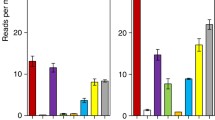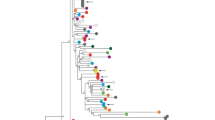Abstract.
In the course of a chromosomal walk towards the centromere of chromosome IV of Aspergillus nidulans, several cross-hybridizing genomic cosmid clones were isolated. Restriction mapping of two such clones revealed that their restriction patterns were similar in a region of at least 15 kb, indicating the presence of a large repeat. The nature of the repeat was further investigated by sequencing and Southern analysis. The study revealed a family of long dispersed repeats with a high degree of sequence similarity. The number and location of the repeats vary between wild isolates. Two copies of the repeat contained degenerated long-terminal-repeat (LTR) retrotransposons, which were named Dane1 and Dane2 (for Degenerated A spergillus n idulans element). The pattern of degeneration suggested that a process similar to the repeat-induced point-mutation (RIP) phenomenon, first described in Neurospora crassa, may have operated in A. nidulans. The data indicate that this family of repeats has assimilated mobile elements that subsequently degenerated but then underwent further duplications as a part of the host repeats.
Similar content being viewed by others
Author information
Authors and Affiliations
Additional information
Electronic Publication
Rights and permissions
About this article
Cite this article
Nielsen, .M., Hermansen, .T. & Aleksenko, .A. A family of DNA repeats in Aspergillus nidulans has assimilated degenerated retrotransposons. Mol Gen Genomics 265, 883–887 (2001). https://doi.org/10.1007/s004380100484
Received:
Accepted:
Issue Date:
DOI: https://doi.org/10.1007/s004380100484




